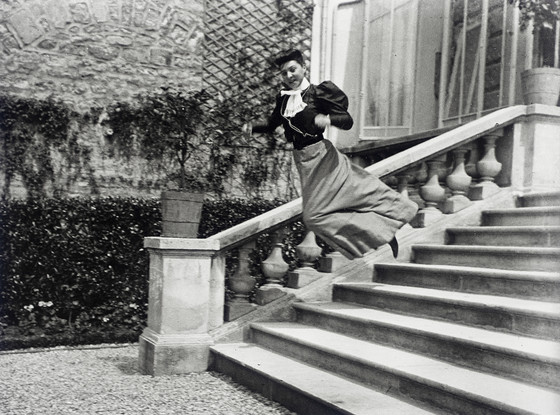Cousin Bichonnade in flight, 1905

Jacques Henri Lartigue was eleven years old when he took this photograph. A child prodigy, he was creating works in his adolescence that would later become recognised as masterpieces in the history of the medium.
Born into one of the wealthiest French families in the country, when he was seven Lartigue was given a large-plate camera and tripod. To operate it he needed to stand on a stool. His obvious delight with mastering the device was surpassed when a year later, his birthday present was a handheld Brownie No.2.
Lartigue’s boyhood photographs were almost always snapshots of friends and family, but his gift for composition gave them a quality that was quite unique – like the picture of his cousin here, taken as she rushed down stairs, captured as though in supernatural flight.
In other early photographs, he finds something magical in what might be considered mundane; pictures of his friends careering around in homemade carts, chasing kites, or attempting to take-off in a crudely-fashioned ramshackle glider.
There was nothing of the stiffness we normally see in vintage photographs. Rather, they were animated, alive with the spirit of wonder. His took boyish delight in taking a self-portrait of his head floating like a balloon in the bath, as he lay beneath the water to create the picture.
It was his capacity to be enchanted by the world, and the enthusiasm that he brought to his images, that make him one of the most beloved photographers of all time. Whether it was a blurred photo capturing the speed of early racing cars, balloon flights, or a charmingly animated street scene, Lartigue could create a sense of playfulness in everything that he drew into his camera lens.
But even in his youthful snaps, he was able to bring a formal sophistication to his informal approach. Of course in his mature career, he was able to perfect the techniques that enabled him to present mysteriously exotic fashion models, with an effortless Vermeer-like delicacy.
Although he was captivated by movement and the camera’s ability to freeze and record passing moments, he appeared to make little attempt to control or compose his pictures in an artistic way. Rather than create ‘art’ with his pictures, as many of his contemporaries were doing, his pleasure came from the uniquely spontaneous qualities of the camera, rather than a concern for photographic craft.
In fact, Lartigue spent much of his life seeing himself as primarily a painter, after studying art at Académie Julian in 1915. He was gifted, and his works sold well, sustaining him financially over the years. He avoided exhibiting his photographs for decades, and it wasn’t until 1975 that he took part in a small retrospective in Paris.
He quickly gained a reputation for striking portrait work, and received the prestigious commission to shoot the official state photograph of the President of France, Valéry Giscard d’Estaing. Soon, he was being offered assignments from leading fashion magazines and newspapers, but despite this interest he continued feel painting was his driving force – that in reality he was a mere amateur photographer.
In fact, his prowess didn’t achieve great international recognition until he was publicly fully discovered, at the age 69, when his photographs were displayed at the Museum of Modern Art in New York in 1963.
During Lartigue’s first visit to America a year earlier, he had a fortunate meeting with John Szarkowski, head of the nascent photography department at the museum. Szarkowski was transfixed, and insisted Lartigue allow him to share his work. The show propelled Lartigue into the spotlight. It was so late in his career, viewers were awestruck that they were being introduced for the first time to one of the founders of modernist photography.
He was greeted by America’s leading photographers as a giant in their midst. It was a telling indication of his extraordinary early abilities that more than half of the exhibition featured photographs taken at an average age of seventeen.
His work was often regarded as enigmatic, leaving the viewer to interpret the view as they wished. For example, in his picture ‘Monsieur Follette and his dog Tupy’, from 1910, it appears that a small spaniel has leapt from his owner’s arms into a narrow river. However, it was also interpreted that the dog had been heartily tossed into the water by Monsieur Follette, with Tupy having to swim back, or be retrieved. In this way, many of Lartigue’s pictures tread the line between reality and a sense of the surreal.
He was a tireless recorder of life and an avid journal keeper who had over 150 photography albums, and 14,500 pages of images and accompanying notes and diaries. Lartigue found recording daily life remained his main subject, and often said ‘I shall worry about the future later’.
He certainly didn’t restrict himself to covering important events or notable people. Lartigue’s body of work is in many ways his autobiography, from which you can view his three marriages, numerous affairs, a love of fast cars, and the comfortable life he led in Paris, a life which witnessed two world wars and the 1920s stock market crash. Before Lartigue died peacefully at 92 at home in Nice, he fondly remembered the time when the pre-eminent American photographer Richard Avedon had asked him if he could spend an afternoon looking through his journals and files. He stayed two weeks.
